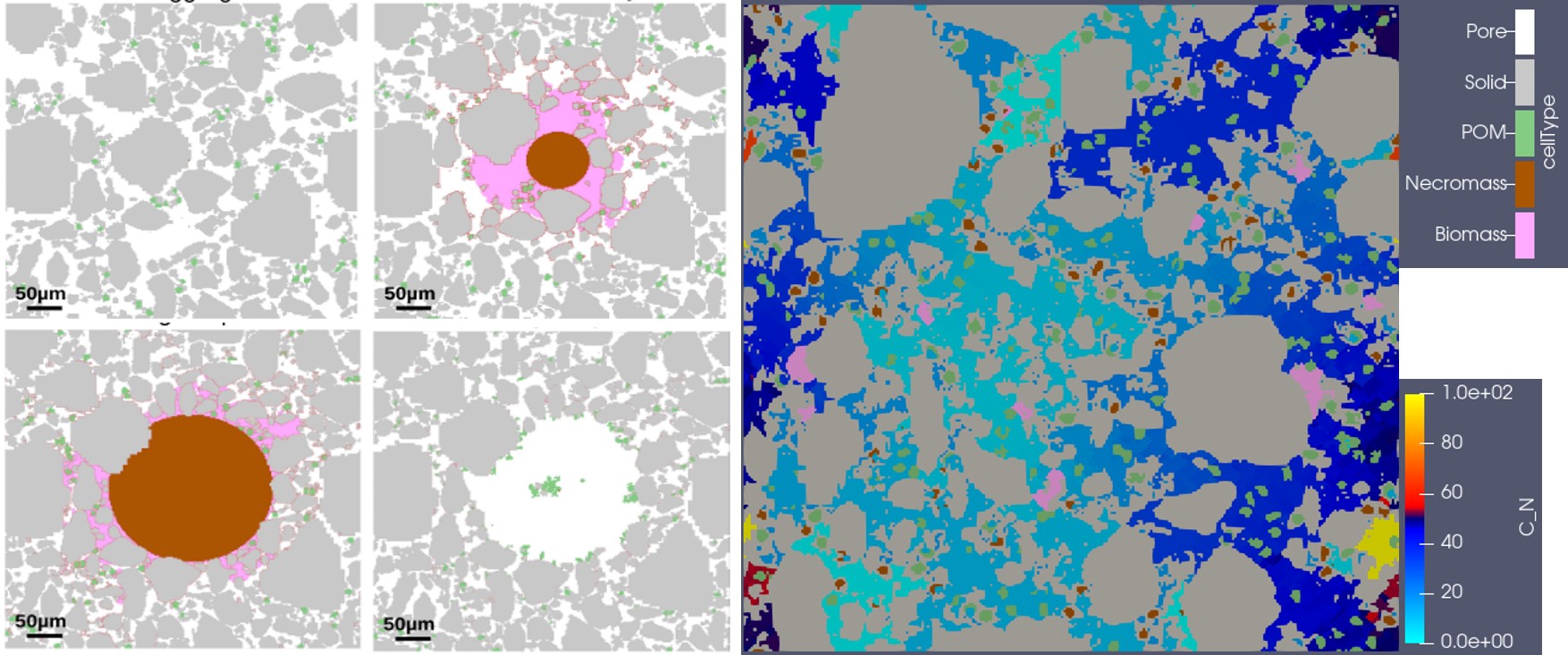P25 - Multiscale Modeling
Multiscale modeling with evolving microstructure: An approach to emergence in the rhizosphere via effective soil functions

Right: C/N dynamics coupled to microbial turnover after mucilage pulse
The self-organization of soil aggregates by various attracting forces influenced by geochemistry, and microbiology is studied by a novel, comprehensive model on the rhizosphere scale that explicitly represents the pore structure. To take into account specific properties of the rhizosphere the functional range of existing models for aggregation or carbon turnover has to be extended and, e.g. an explicit phase of mucilage, root dynamics or C/N specific microbial growth included. The project aims at the development of a mechanistic modeling approach that allows for dynamic structural reorganization of the rhizosphere at the single root scale and couples this evolving microscale model to the root system scale including the inference of soil functions. The SPP collaborations help to formulate the process mechanisms, and the CT scans reveal the pore structure in different settings. We model transformation processes in the rhizosphere and describe them in a rigorous way including couplings to geochemistry, microbiology, and finally to soil functions. Thus we gain insights on the development of self-organization in the rhizosphere in connection with spatiotemporal patterns of nutrients, water and biomass. The persistence of soil structure formation is studied as a function of the presence and development of gluing agents and soil carbon dynamics.
Due to its high complexity, the rhizosphere model is not amenable to large scale computations. The homogenization technique enables us to incorporate information from the rhizosphere scale on the macroscale. We advance upscaling techniques to dynamically evolving microstructures taking the spatiotemporal evolution of the rhizosphere into account. The derivation of effective parameters (e.g. diffusivity, permeability) can be an important input in existing root-water uptake models. We need a numerical approximation of the derived mechanistic model and its integration in an efficient software tool using massively parallel architecture.
Outcome
The upscaling methods allow to characterize the soil function effective diffusivity on the basis of several thousands of CT samples and quantify, e.g. the extent of the influence of biopores and revealed that conventional forumals as the Millington-Quirk formula systematically overestimate effective diffusion (
Prechtel et al., 2022
). They also can account for anisotropic, reduced diffusivity in a mucilage phase, which may even enhance the effective diffusivity by facilitating the connectivity of the liquid phase (
Schnepf et al., 2022
). The performance of alternative measures relying, e.g., on the mean and variance of geodesic tortuosity is evaluated in
Prifling et al., 2023
With the help of the fully dynamic spatial and image-based modeling tool we investigate how soil aggregation, root growth and exudates mutually interact at the pore scale (
Rötzer et al., 2023
). This allows the simultaneous simulation of the dynamic rearrangement of soil particles, the input and turnover of particulate organic matter, root growth and decay as well as the deposition, redistribution and decomposition of mucilage. The interactions are realized within a cellular automaton framework. The most stable configuration is determined by the amount and attractiveness of surface contacts between the particles, where organo-mineral associations preferably lead to the formation of soil aggregates. Their break-up can be induced by root growth or the degradation of gluing agents previously created after the decomposition of POM and mucilage. We evaluate various scenarios and quantify the displacement intensity of individual particles and the variations in local porosity due to the change in available pore space as influenced by the root growth and observe compaction, gap formation and a biopore evolution. The simulation results support that the deposition of mucilage is an important driver for structure formation in the rhizosphere. Although mucilage is degraded within a few days after exudation, it leads to a persistent stabilization of the aggregated structures for both textures in the vicinity of the root. This stabilization is significantly different from the structures encountered when only POM could trigger the evolution of gluing spots, and is still present after complete degradation of the root.
Further aspects incorporated include microbial necromass and C/N specific pathways of microbial transformations. This allows the tracking of different C pools and the identification of hot/cold spots in space and time to better understand carbon turnover in the rhizosphere.
Link to English
scientific abstract
Link to German scientific abstract
